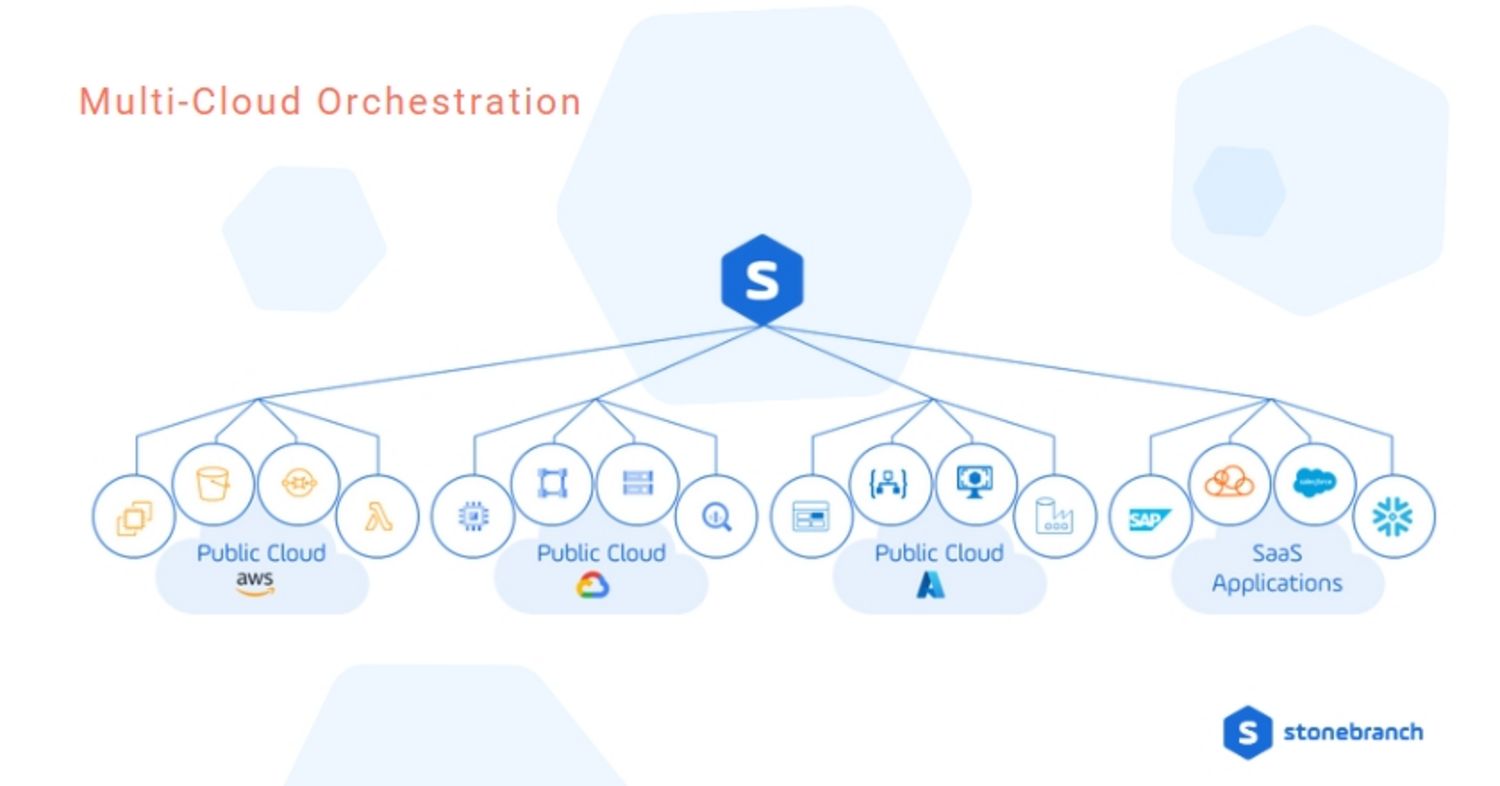Cloud Orchestration and Automation Explained
Cloud orchestration and automation are two essential components to boost business efficiency and productivity in multi-cloud/hybrid IT environments. Paired together, they offer a recipe to boost business metrics.

Editor’s Note: Given the continued evolution of IT automation, we thought it timely to refresh our 2020 point of view on cloud orchestration and automation.
Cloud orchestration has become a critical part of the multi-cloud and hybrid IT infrastructure for most major enterprises — but being in the cloud does not simply mean the secure storage of critical data.
When automated, cloud jobs and essential task workloads are taken care of in a fraction of the time, boosting business efficiency and productivity manifold. Why simply adopt cloud jobs without automation, or automation without cloud jobs? Together, the benefits they hold for your business are astounding.
Read on to learn how to orchestrate your cloud when combined with a modern workload automation (WLA) software solution.
What is Cloud Orchestration?
Cloud orchestration is the central management of automated tasks, or jobs, in disparate cloud systems. Automated jobs from each cloud tool are controlled from a single platform. Centralizing control via an orchestration layer allows enterprises to create interconnected workflows that span multi-cloud environments.
All too often, IT processes are developed within organizations on a reactionary basis — an approach that quickly leads to silos of automated tasks and point solutions. Isolation is toxic in the world of automation, however, and these silos quickly become drains on both time and money.
In order to mitigate the high risk and high cost of automation silos, IT operations decision-makers — in cooperation with cloud architects — have turned to orchestrating the siloed jobs into connected workflows that span across their entire IT operations environment.
This concept has an advocate in Gartner, who recently released the 2023 update to its Market Guide for Service Orchestration and Automation Platforms (SOAPs). One of the primary themes of the report ties to using a SOAP, which Gartner categorizes as an evolution from traditional on-premises WLA, to orchestrate complex hybrid IT cloud environments.
Benefits of Cloud Orchestration
Cloud orchestration solutions allow organizations to move to a true hybrid infrastructure without having to worry about the interconnectivity and interaction between systems.
Other benefits include:
- Innovation: A fully orchestrated hybrid IT system allows for a more creative approach to IT that will inevitably help IT Ops problem-solve more efficiently.
- Full control at your fingertips: No more worrying that your solution is only giving you a partial picture of your enterprise’s IT landscape — it’s all there, within a single pane of glass view.
- Compliance guaranteed: Orchestrating an entire system to work as one allows for universal built-in checks and balances, so your system is always compliant.
- API management with superpowers: Orchestrated workflows can call up APIs like tools from a toolbox to perform specific tasks based on event triggers, making for seamless coordination and synchronicity.
- Cost control: Cloud based systems are fundamentally different from on-premises. An automation-first approach is required to manage cloud resources cost effectively… or even reduce costs.
- Future-proofing: With cloud orchestration, IT operations teams can sleep well at night rather than worrying about the future of their IT environments.
The right cloud orchestration tool can serve as a single point of control for the entire system, resulting in superior performance and consistency.
Cloud Orchestration Use Cases With Workload Automation
Cloud orchestration sounds great on paper, but how does it work in practice? Let’s examine a couple of real-life examples.
Use Case 1: Automating Tasks with Cloud Service Providers Like AWS and Azure
A modern workload automation solution will be able to orchestrate any hybrid environment, whether it be hybrid cloud or even multi-cloud (an ecosystem composed of more than one public cloud service provider).
WLA software can build workflows across multiple platforms that enable the entire IT system to work as one unified force. To do this, it needs to work with all cloud service providers as well as on-premise and distributed environments.

This requirement means the WLA solution must have the flexibility to integrate with existing applications and data within those environments. We outline several key features of both the AWS and Azure clouds below, providing some simple technical examples of how a WLA solution helps to automate them as part of a holistic hybrid IT ecosystem.
Amazon Web Services (AWS) Automation
AWS has emerged to be the most prominent public cloud provider; they’ve grown to offer 100+ services in over 20 regions across multiple continents. Among these services are various offerings for server, storage, and database resources.
So, how does a modern WLA help automate key features?
- EC2 (Elastic Compute Cloud): WLA can provision multiple EC2 instances, and an Amazon Machine Image (AMI) allows you to provision a customized server. With EC2 and WLA together, you can provision a custom, event-based server in any AWS region.
- RDS: The database offerings from AWS (such as Aurora) — and even data warehouses such as Redshift — can be automatically provisioned by the right WLA solution.
- Cloud Storage: AWS offers multiple storage tiers such as S3 and Glacier. WLA can centrally automate long-term log storage; for example, tasks can be executed daily or weekly to compress logs and then transfer them to S3.
- Beyond Default APIs: AWS has APIs that allow resources to be manipulated programmatically. WLA can be used to fill the gap for APIs that function in a "fire and forget it" manner.
Azure Automation
Like AWS, Microsoft Azure is one of the largest public cloud providers in the market. They currently have over 600 services in 52 regions around the globe.
Below are just a few examples of how evolved WLA solutions automate key features:
- Container Instances: WLA solutions will automatically deploy containers to the cloud using the event-based trigger approach, which provides increased agility with containers on demand.
- Auto Erase: WLA will automatically erase the containers when no longer needed, thus reducing Virtual Sprawl. (Virtual sprawl means there are too many unnecessary containers or machines, and administration cannot handle them all).
- Virtual Machines: WLA automates the on-demand requirements to spin up virtual machines in minutes. Sure, Azure can do that on its own — if someone goes and configures it. But this won’t always be available. WLA solutions will automate this process via containers when triggered by DevOps, Service Management, and other applications that business users natively use — without ever having to request support from IT.
- Azure Cloud Scheduler: Though Azure has a built-in cloud job scheduler, WLA solutions will be cloud-agnostic, allowing enterprises in a multi-cloud environment to automate across all cloud service providers within their environment. This helps to unify diverse landscapes, while allowing complex and nested workflows to be created with ease.
Use Case 2: Compliance and Security Updates Across Hybrid or Multi-Cloud
Imagine your organization utilizes a hybrid cloud and multi-cloud infrastructure. There are applications residing in two separate public cloud service providers, as well as on a private cloud. How do you easily make compliance and security updates across all these applications, regardless of where they are housed?
Without the right orchestration and automated approach, this is a highly manual effort; it requires disconnected scripts, native job schedulers for each application, and changes made by the people on staff.
Using a WLA solution, a cloud orchestration approach can schedule and install the updates across all platforms during a maintenance window from a single “command-center” type of interface.

Use Case 3: Hybrid Cloud Storage and File Transfer
When operating in a hybrid environment, organizations realize that their data needs to be portable to anywhere at any time. But creating a data pipeline that's fast, accurate, and secure can be a problem.
Suppose, for example, you have a data pipeline in place where data must be transferred between public and private cloud platforms. However, imagine it must be transferred to Amazon S3 and then Azure Blob storage for redundance. In addition to that, the input data first needs to be aggregated from several different on-premise environments such as Windows, Linux, and Unix?
Without a central orchestration layer like WLA, you would need stand-alone job schedulers or cloud schedulers for each cloud or on-premises source solution, data tool, and cloud storage tool used along the data pipeline. Then you would need a stand-alone managed file transfer tool to actually move the data files. This example setup is ultimately challenging to manage, does not provide observability into the pipeline, and makes it difficult to identify issues when something breaks down.

With a WLA-driven cloud orchestration platform in place, your data can securely cross the firewall or the silos between multiple cloud service providers. WLA uses several secure methods to move data back and forth via hybrid managed file transfer. MFT is native to the evolved WLA solution — so you can make this whole process based on system triggers or events.
Rather than waiting for time-based jobs or batches, the event-based trigger approach to hybrid cloud storage and file transfer allows organizations to manage their data pipeline in real time.
By centralizing the management under an orchestration layer, you gain observability into the whole process. Visibility includes system logs for all data movements, real-time alerts when a job fails, SLA alerts if the pipeline is delayed or out of sync, and the ability to drill into any of these issues with a few clicks of a mouse.
Conclusion
With the prevalence of hybrid cloud environments today, cloud orchestration is critical to realize the full benefits of your hybrid landscapes. Proper orchestration serves as a single point of cloud management — ensuring all aspects of interconnectivity between the systems.
Cloud orchestration, when combined with workload automation, also reduces errors by reusing automated tasks as building blocks. Orchestration enables a truly scalable and flexible infrastructure.
Start Your Automation Initiative Now
Schedule a Live Demo with a Stonebranch Solution Expert






